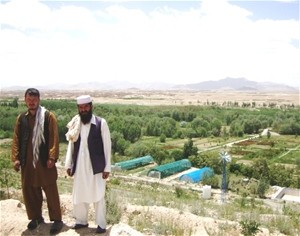
The Executive Representative of the Ghazni Agricultural Department in Jungal Bagh stands with an assistant on a hill
Mohammad Noori / CADG
Thirty years of rampant deforestation created se-vere erosion problems in Ghazni. Villagers suffered extensive damage to irrigation systems and subsequent loss of arable farmland.
10 OCTOBER 2012 | GHAZNI, AFGHANISTAN
More than 30 years of deforestation has severely damaged Ghazni agriculture. In the 1970s, most of Afghanistan’s 2.5 million hectares of forest grew in Ghazni and other provinces near the border with Pakistan. Today, nearly 90% of these forests have been lost.
“When the Russians were here, they would set fire to the forests around Ghazni where the Mujahedeen were hiding. The Taliban adopted the same practice – this time to attack villages that resisted them,” Ghazni Director of Agriculture and Irrigation Sultan Hussain, reports. “After the war, the residents of Ghazni cut down the remaining trees for fuel. There was no other source of power, so people were forced to cut down the forest.”
Once the foothills and valley catchments were stripped of trees, there was little to stop the rivers of mud and rock that washed down from the mountains each spring. Floods suddenly did far more damage to fragile valley irrigation systems, driving farm-based local economies into poverty.
In 2009, Director Husain joined with a small group of residents to reforest critical catchments near Ghazni city. By the spring of 2010, the group had managed to plant 8,000 saplings but were struggling to find nursery land and water for seedlings to expand their operations.
Between March and September of 2010, Central Asia Development Group (CADG), a USAID implementing partner, worked with 758 Ghazni residents to plant 10,000 pine saplings, clear 10 square kilometers of nursery grounds and excavate 11 kilometers of canals to irrigate the Jungal Bagh plantation. “We were very small when we began work with CADG,” Mr. Husain said. “The nursery grounds, the saplings and the irrigation system have given us a path to reforesting all of Ghazni’s important farm valleys within the next 10 years.”
By the spring of 2012, the Jungal Bagh nursery was home to 80,000 saplings, and farm staff transferred 70,000 saplings from the nursery to streets, lanes, schools, clinics and mosques in Ghazni city. Equally impressive, the agriculture department confirms that it is on schedule to plant one million trees by the end of 2013. Mr. Hussain credits USAID and CADG for the critical early push that allowed this program to gain traction.







Comment
Make a general inquiry or suggest an improvement.